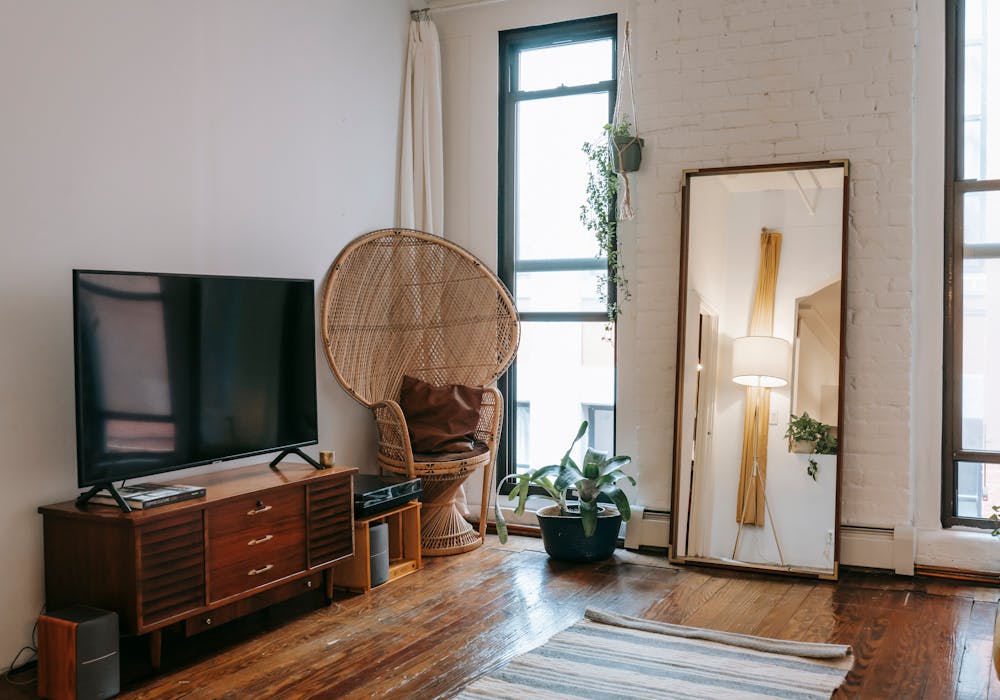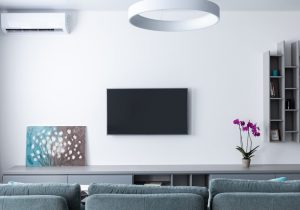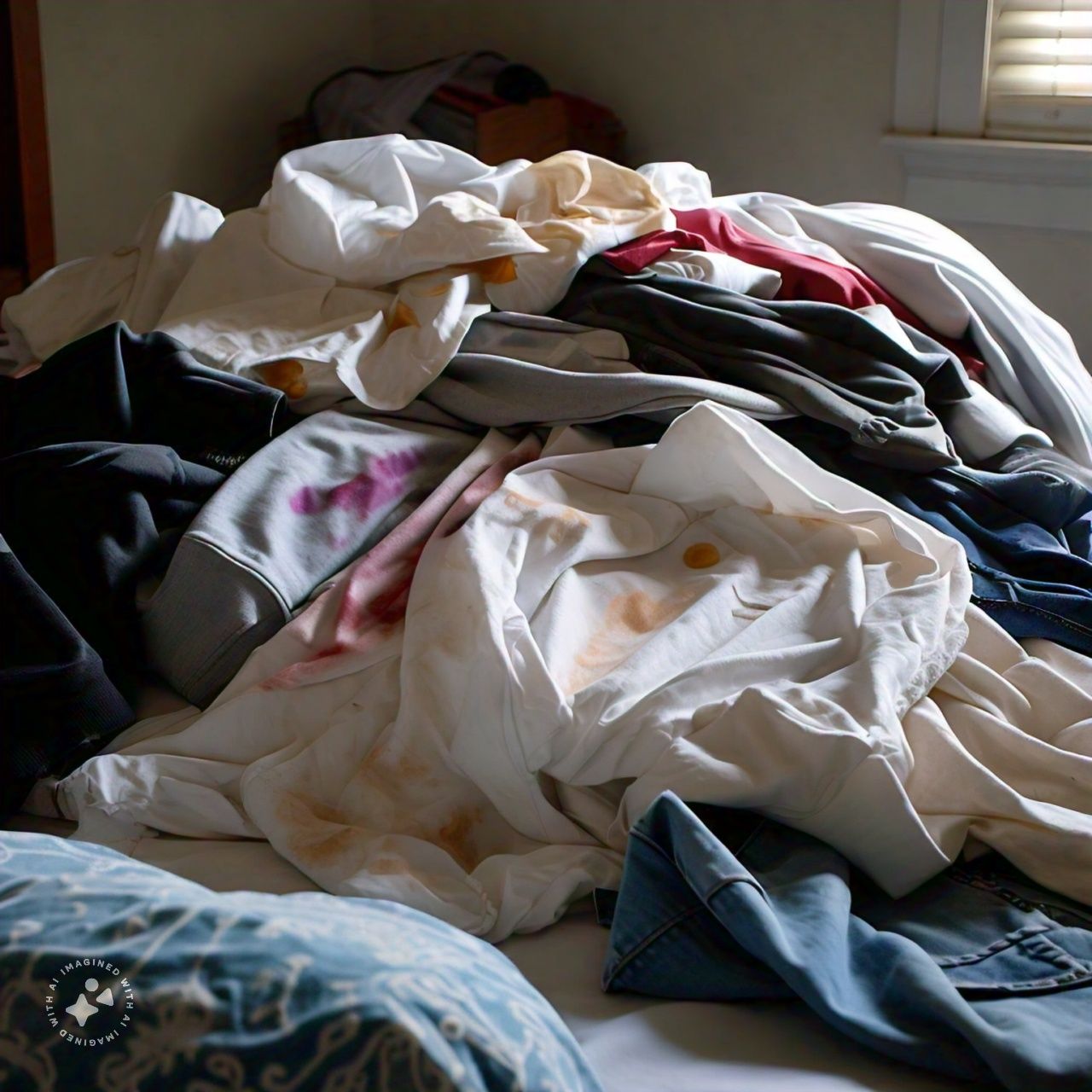Home Improvement
10 Small Living Room Ideas With Tv That Are Trending Now

Advances in new materials and technologies have revolutionized various aspects of our daily lives, including interior decoration and design. In particular, the aesthetics of televisions, one of the most sought-after devices, have undergone a complete transformation over the years. In this article, we explore how these advancements have influenced small living room ideas with TV.
Traditional tube televisions have been replaced by flat screens, which, on many occasions, resemble a painting on the wall. The fever for plasma, LED, LCD, and smart TV screens is undeniable. To adapt to this technological revolution, designers have reinvented the supports and furniture for incorporating TVs into social spaces like the living room, resulting in extremely attractive designs.
Here are the top 10 trending ideas for your small living room with TV.
1. Spatial functionality

One of the greatest contributions of the evolution in the aesthetics of televisions is that, currently, they simultaneously fulfill their practical function in addition to adding a unique appeal to the spaces they occupy. If you are passionate about new technologies, designing your small living room as an entertainment center in which to place not only the television, but other complementary elements such as a home cinema , a multimedia station or similar will give this room in the house the consistency you need to get the most out of it.
2. Dividing spaces

When it comes to enjoying company, television can act as a connecting link or dividing line as appropriate. This small living room with television fulfills this task perfectly and the device is located against the wooden wall that allows a visual connection with the dining room and kitchen area. Furniture in light white and gray tones completes the originality of the design of this dividing element, conveying a very cozy feeling.
3. In view of everyone

One of the keys to interior design and decoration is that it reflects, to a certain extent, the personality of those who are the judge and part of its use and enjoyment. Reading and entertainment in the form of television go hand in hand in the proposal that we present to you in this small room that combines both passions in a masterful way. A large bookcase makes clear the taste for books and acts as a support for the television which, on the other hand, focuses the attention when the situation requires it.
Or hidden behind closet doors
The same proposal allows drawing attention only to the large library, thanks to the magenta doors behind which the television is hidden. The lighting integrated into the shelves as well as the contrast with the rest of the furniture in dark tones give the set a touch of elegance and distinction that does not renounce the freshness and vitality provided by the cabinet that houses the television.
4. Blended with the environment

If there is one characteristic that defines this small living room with television, it is modernity. Its design is an example of a contemporary taste that is present not only in the lines of the furniture, but in the choice of gray as the color that bathes the entire room. The television becomes the focal point of the room which, with an L-shaped distribution, organizes the space around a device that is completely integrated into the design.
5. A space for relaxation

A living room with television, whether large or small, is a space designed for your use and enjoyment and, as such, it must incorporate the necessary resources so that comfort is one of its hallmarks. Despite its small size, this small living room with television has a multitude of resources at the service of relaxation: from a comfortable sofa to lighting capable of creating different environments, including the detail of the skylight that fills the space with natural light, the nuances of organic design such as the log lamp, the rug or the choice of colors and materials that, in short, give life to a cozy room with a certain rustic air.
6. With a lot of art

The television is a decorative element with its own character within the living room. However, its presence is not at odds with other elements that add charm to the design. In this proposal, we use some pictures on the wall, attractive wallpaper, and elegant, contemporary furniture to complete the charm of a room exuding distinction.
7. Originality made design

As articulated at the outset of this ideas-driven article, the rejuvenation of television aesthetics has made a profound impact on interior decor, offering innovative and captivating concepts. For those seeking an alternative to conventional designs, embracing bold and avant-garde arrangements can be incredibly rewarding. Consider, for instance, a striking configuration where a circular piece of furniture surrounds the television area, serving as a focal point in this contemporary living space.
8. A small and long living room

The available space determines, in part, the design of any room without this meaning having to opt for unattractive proposals. A minimalist approach, in which the maxim of less is more is fulfilled, is all that this small elongated living room with television needs to create a cozy space. The device itself goes practically unnoticed, so the weight of the aesthetic appeal falls on the sum of all the details from the furniture to the lighting and the color nuances.
9. Industrial design

Any style you imagine has a place in a small living room to which you want to incorporate a television. The industrial aesthetic, for example, imbues this space with meaning, combining furniture and accessories of contrasting aspects, such as lamps and sofas reminiscent of another era, with pieces boasting a marked industrial character, such as furniture with rivets On the other hand, the mirror wall in the form of sliding doors makes the living room appear larger.
10. A very chic space

Who said a small living room with a television couldn’t be chic? Here you have a very inspiring example of how to give a very attractive look to your design from a minimalist perspective full of details. The play of black and white contrasts in furniture and accessories is the key to giving life to this space with an unquestionable personality. Plants, a zebra-print rug and even an original design pouf put the ‘icing on the cake’ to a simply charming proposal.
Conclusion:
Designing a small living room with a TV involves considering both functionality and aesthetics. With advancements in technology and design, there are various creative ways to integrate a television into your space, from spatial functionality to blending it with the environment seamlessly.
How to put the TV in the living room?
The ideal placement is where the center of the screen aligns with eye level when seated for optimal viewing comfort. Additionally, consider the appropriate screen size relative to the room dimensions for a balanced visual experience.
Where to place the television in the living room?
The TV should be positioned perpendicular to windows, avoiding placement directly in front of them. This prevents uncomfortable reflections from natural light, preserving the image quality.
How to put a screen on the wall without a support?
Steel cable: This alternative enables TV mounting without the need for a traditional stand. It involves using a metal cable and circular brackets to secure the TV to the wall, similar to hanging a painting. The back of the TV connects to the steel cable, which is then inserted into the wall anchor for stability.
Read Also:
Home Improvement
How to Remove Stains From Clothes With Some Household Items

We often wonder how to remove a stain. And if there are any stain specialists, it’s our darlings! Our future artists often confuse their copies with their clothes: pen stain, grease stain, paint stain… The list goes on! Let’s get ready to make them disappear! Here’s how to remove stains from clothes.
Some Quick Tips for Removing a Stain More Easily
Speed of action:
A stain that has just been done can be removed more easily because it has not had time to irreparably damage the fibers.
Basic rules:
If you just got a stain and you’re not sure what to do, wet the stain with cold water (heat can set the stain permanently), scrub it fabric gently with vegetable oil or Marseille soap, rinse with cold water and hang the garment in the shade.
Test fabrics:
Each fabric reacts differently to solvents. Put a single drop on a hidden part of the garment to test the reaction before cleaning your stain.
Delicate and colored fabrics:
Use a clean cloth that has been soaked in a suitable stain remover and pat without rubbing.
Durable fabrics:
Take a clean cloth soaked in a stain remover. Fold the cloth and rub it softly between your hands.
Use the same fabric to avoid pilling:
Using the same type of fabric as the garment being cleaned (e.g. wool with wool, cotton with cotton, and silk with silk, etc.).
Move the stain:
When removing stains, place an absorbent cloth such as cotton or paper towel, so that when diluted it will move from the fabric to the fabric below
Avoid marks:
Use a minimum of solvent and rub gently to avoid marks on t-shirts for example.
Stubborn stains:
Before washing, wet the garment with cold milk and soak it in salt water overnight.
Wash it and hang it to dry : for each solvent, use as little as possible to avoid damaging the fiber. Wash in cold water, and hang your garment in the shade.
How to remove stains from white clothing?
White clothes are wardrobe essentials. However, they tend to yellow over time. To whiten your white shirts and t-shirts without damaging them, use lemon juice. The method is simple:
- Pour lemon juice into a basin of cold water at the rate of 3 lemons per liter of water
- Soak the clothes for an hour
- Rinse thoroughly with clean water.
Have you spilled an oily product, coffee or tomato sauce on your white dress? Rest assured, there is still a solution to restore its shine. Here’s how to remove a grease or coffee stain from your clothing:
- Rub the affected area with Marseille soap (do not wet the stain)
- Leave to act for an hour
- Lather the soap with water
- Scrub again, possibly using a soft-bristled brush
- Wash the garment directly in the machine.
How to remove a difficult stain from colored clothing?
Here are the rules to follow to remove stains from colored clothing without damaging it:
- Treat the stain before machine washing
- Make sure that the stain remover does not discolor the fabric (be careful with soda crystals)
- Avoid harsh products like bleach
- If the traces resist the chosen stain remover, rinse before switching to another. Indeed, the products risk mixing and damaging your clothing.
Now that you know the precautions, move on to cleaning using 70° alcohol. You can use it to remove grease stains from colored clothing . 70° alcohol is just as effective against traces of ink or blood.
Follow these 2 simple steps:
- Dab the stains with a cloth soaked in alcohol
- Rinse as quickly as possible.
The baking soda/shampoo combination is also an excellent alternative:
- Pour a dab of shampoo onto the stained area
- Rub gently
- Sprinkle with baking soda
- Rub again
- Rinse immediately.
How to remove stains from clothing?
Ammonia is one of the products capable of removing stubborn stains such as those left by grape juice, red wine or blood. However, it should be used with caution. By wearing gloves, you will avoid contact with your hands. Cleaning should also be carried out in a ventilated area. Indoors, remember to open doors and windows beforehand.
Focus on the steps to follow to remove stubborn stains from your clothing:
- Dilute the ammonia with water (the more fragile the fabric, the more diluted the cleaning product should be)
- Dab the stain with a cloth soaked in the mixture
- Rinse as quickly as possible
- Machine wash your garment.
Ink, ketchup or foundation stains on clothing? Rubbing alcohol comes to your rescue. In addition to its disinfecting power, this household product gets rid of stubborn dirt, especially since it is easy to use. You simply need to:
- Get yourself a cotton swab
- Soak it with a mixture of water (¼) and alcohol (¾)
- Dab the stubborn stain with this preparation
- Machine wash your garment.
How to remove a stain from already washed clothing?
Ink marks are among the most stubborn stains. Fortunately, it is possible to get rid of it using 2 tips: vinegar or toothpaste.
Here’s how to remove an ink stain from previously washed clothing :
- Soak it with white vinegar
- Rub
- Rinse.
You can also :
- Moisten your clothing
- Scrub the ink stain with a little toothpaste and a brush
- Rinse.
Note that this second solution also works on oil or butter stains.
How to remove stains that won’t go away?
Have you tried several tips, but none seem to work? Try to rub some Marseille soap on the stain. This cleaning product is your ally in removing stains and keeping your clothes clean and spotless. It is effective for:
- Remove greasy stains from clothing
- Eliminate traces of coffee, sauce or chocolate
- Whiten laundry
- Deodorize washable textiles (curtain, tablecloth, carpet, etc.).
To remove stains with Marseille soap, nothing could be simpler
- Rub the soap on the stain.
- Leave it for 15 minutes.
- Rinse.
FAQs
How to remove stubborn stains from clothes?
It is also possible to soak the stain in cold salt water, then rub with a Marseille soap stain remover stick and leave to act for approximately 1 hour. Once the product has worked, simply clean again with a cloth soaked in water with a drop of white vinegar.
Does baking soda remove stains?
Baking soda does even worse, it has no effect on greasy and oxidizable stains, it only removes old blood stains relatively well . So stain remover manufacturers don’t have to worry, their products will continue to sell.
How to remove stains after washing?
If a grease stain is still present on your tablecloth or clothing after it has been put in the washing machine, start by rubbing the stubborn stain with dry Marseille soap. Once a sort of crust has formed, leave it on for about 15 minutes.
Read Also:
Home Improvement
Exploring Exterior and Interior Wall Insulation: A Comprehensive Guide

Learn the ins and outs of exterior and interior wall insulation in this comprehensive guide. Discover everything you need to know to keep your home comfortable and energy-efficient.
How to insulate the walls of a house from the outside?
Insulating walls from the outside is more efficient. This method is indicated for houses that also need a facade renovation.
Exterior insulation under coating
This process is the most affordable in terms of exterior insulation. It consists of fixing the insulation panel to the wall using different techniques:
- Bonding, with prior stripping of the wall in the event of renovation;
- Wedging with mortar, followed by fixing using dowels;
- The use of profiles to form retaining rails.
After fixing the insulation, the professional makes joints between the plates. He then proceeds to the finishing with the installation of the coating.
Exterior insulation under cladding
In addition to insulation, cladding allows you to renovate a wall in poor condition. Knowing that the facade will be modified, an authorization request must be submitted to the municipality before carrying out the work.
The insulation technique under cladding consists of fixing a frame on the wall, then installing the insulating plate on it. This frame is then covered with cladding, keeping an air gap to ensure moisture evacuation.
You have the choice between different types of cladding: wood, steel, aluminum, etc. This covering considerably improves the exterior appearance of the wall while ensuring effective protection against bad weather.
Which insulation to choose and what thickness for wall insulation?
Several materials are available for wall insulation:
Natural insulators
Natural insulators such as cellulose wadding, sheep’s wool, cork or plant fibers are especially suitable for interior insulation. Their price is generally higher compared to other materials.
Synthetic insulators
Synthetic insulators such as polyurethane (PU) or expanded polystyrene (PEE) are suitable for exterior as well as interior insulation. They are especially interesting in the form of plates. Their price is more affordable compared to natural insulators.
Mineral insulation
Mineral insulation such as glass wool or rock wool. They exhibit excellent thermal and acoustic properties. In addition, their price is much more accessible like glass wool. Available in several shapes, they are also easy to set up. Glass wool is one of the most efficient materials, providing good resistance with a limited thickness. It also offers good sound insulation.
Depending on the insulation technique chosen, it is possible to use insulating plates or bulk materials. For example, in the case of interior insulation under a metal frame, the professional can opt for blowing in loose insulation if necessary. Thus, the wall is completely covered despite the irregularities.
The thickness of the insulation is determined by the condition of the wall and the performance of the chosen material. Following exterior insulation work in energy renovation, the walls must achieve a thermal resistance of 3.7 m2/K/W. The craftsman will be able to determine the most appropriate thickness to achieve this resistance, taking into account the performance of the material.
How to properly insulate a wall from the inside?
Insulating walls from the inside is both simpler and more affordable. It is done piece by piece. This method is interesting for homes with a facade in good condition or one that cannot be modified.
Insulation of a smooth wall by glued lining
For a wall in good condition and perfectly flat, insulation by glued lining is the most practical. This involves directly gluing lining panels to the wall using glue or adhesive mortar.
The panel is made up of an insulating board and a plaster facing board which are glued together. The facing plate is used for finishing, you can then paint it or cover it with wallpaper. There are lining panels suitable for damp walls to prevent the effects of condensation.
Installation of air gap insulation: an effective method for insulating a porous wall
The air gap insulation method is recommended for walls made of soft stone, rammed earth, lime joints or any other porous material. It is also an interesting solution for walls very exposed to bad weather. The installation of an air gap ensures the water balance of the wall.
The operation requires the installation of battens to accommodate the insulating plate. A minimum distance of 2 cm must be kept between the wall and the battens: this is the air gap. This will absorb the hygrometric variations of the wall. Installing a vapor barrier helps protect the interior from humidity.
Insulation under metal frame: an ideal technique for old walls
In the presence of a wall with an irregular surface or in poor condition, the method of insulation under a metal frame is particularly suitable. However, it can also be applied to flat walls in good condition, in renovation as well as in new buildings.
The insulation plate is directly attached to the wall, then held by a metal frame. On this, the craftsman places a plasterboard finishing plate. With this insulation from the inside, it is possible to pass cables and pipes without drilling the wall or the insulation. They can in fact circulate behind the finishing plate.
The masonry counter-partition, an impeccable finish for irregular walls
This technique is also interesting for damaged walls, especially if you want an aesthetic finish. It consists of directly fixing the insulation to the wall, then installing a new wall in front in order to trap the insulation there.
The thickness of this added wall is approximately 5 cm. It is made of tiles or plaster bricks, and therefore covered with a coating.
Conclusion:
Insulating your home’s walls, whether from the exterior or interior, is essential for maintaining comfort and energy efficiency. Exterior insulation methods, such as under coating or cladding, offer effective solutions for renovating and enhancing the facade while providing insulation. When selecting insulation materials, consider options like natural, synthetic, or mineral insulators, each offering unique benefits and performance.
For interior insulation, techniques like glued lining, air gap insulation, or insulation under a metal frame provide practical solutions tailored to different wall conditions. Whether improving thermal resistance or addressing irregularities, proper insulation contributes to a more comfortable and sustainable living environment.
Read Also:
Home Improvement
How to Move a Refrigerator Properly? Useful Tips and Tricks

When you move your house, the question that comes to your mind is ” How to move a refrigerator ?” It is perfectly normal for you to think and feel uneasy. Because the refrigerator is one of the largest items in our home. In fact, when we compare it in terms of weight and size, the refrigerator is the most troublesome item to carry in our home. In this article, I will explain to you how the refrigerator should be transported and the questions you need to know about its transportation. Thanks to the experiences we have gained over the years, I will tell you the tips of carrying a refrigerator.
How to Move a Refrigerator?
This tip will discuss the correct way to move a refrigerator. It seems quite trivial, right? But did you know, it turns out that mistakes in moving the refrigerator can damage the components inside. It will help you if your refrigerator has four wheel axles so it is easy to move by simply sliding and pushing. But if not, you need to be more careful when moving it. Here are a few useful tips for moving a refrigerator correctly.
Defrost
Turn the refrigerator panel to defrost mode. We often encounter frozen water deposits in the freezer like frost. Under normal conditions, this process will take around 6-8 hours. It’s best to do this at night, so that in the morning you just drain the water and dry it.
Empty the refrigerator.
After the ice has melted, remove all food and drinks from the refrigerator. Choose food that is still good and set it aside or throw away anything that has wilted. Pack in a plastic bag or box.
Remove the shelves inside.
It is a good idea to remove all the shelves, compartments and trays in the refrigerator temporarily. Then, wrap each one in cloth or paper and then put it back together after the moving process is complete.
Disconnect the electrical connection.
Unplug the electrical connection and let it sit for several hours before cleaning. Gently wipe and clean every corner with a soft cloth.
Refrigerator Moving Process
Things to pay attention to when moving the refrigerator:
Packing
If necessary, cover the refrigerator with a soft cloth or cardboard. This can reduce the risk of abrasions due to impacts when moved.
Transport in a standing position
Slowly, transport the refrigerator in a standing position, do not lay it down. Inside the refrigerator, there is an important electronic component called the compressor. Wrong position when transporting the battery causes oil leaks in the compressor.
Use tools.
Ask family or friends for help in transporting the refrigerator. To make the moving process easier, use tools in the form of hand trucks, dolly straps or lifting straps.
Pay attention to the position of the refrigerator.
Pay attention to positioning the refrigerator after moving. Try not to immediately turn on the refrigerator, leave it for several hours after moving, ideally 2-3 hours. Don’t place the refrigerator close to a wall or other object behind and on either side of the refrigerator body, leave a distance of several cm, remember that in the refrigerator body there is a condenser/heat exhaust pipe (try holding the refrigerator body and it will definitely feel warm/hot).
Replace the shelves inside
After the move is complete, reinstall the shelves, compartments and trays that were previously removed temporarily. If you have plugged in the electricity connection to turn on the refrigerator. Those are the important tips for moving a refrigerator when moving.
FAQs
How to move a refrigerator easily?
Tilt the refrigerator against the wall and place the two front corners on folded towels. Next, tilt the refrigerator forward, away from the wall, and slide it forward a few steps using the towels. You will need two or more people to do this safely.
How to move a fridge without damaging the floor?
- Move a refrigerator without scratching its floors
- Defrost your refrigerator first.
- Remove the shelving and attach the doors.
- Get a cart or hand cart.
- Use folded towels or cloth mats to protect the floor.
- Loading the refrigerator onto the trolley or trolley.
Can you transport a fridge lying down?
Whether the fridge is new or not, remember that you should never transport a fridge horizontally, otherwise you risk damaging it. It is imperative to keep it in a vertical position, or as vertically as possible, and ensure that the motor always remains downwards.
How to move a heavy fridge?
First of all, do nothing and leave the fridge stable for several hours after unplugging it. Then, remove the drawers, bins and windows so as not to break them during transport. After that, you can finally move your refrigerator with a hand truck and straps, preferably standing up.
Read Also:
-

 Top2 years ago
Top2 years ago2022 US House committee releases Trump’s tax returns, capping a years-long battle
-

 News1 year ago
News1 year agoUSPS EMPLOYEE ASSISTANCE PROGRAM SERVICES AND BENEFITS
-

 Top2 years ago
Top2 years agoInterview With Niantic CEO John Niantsullivan
-

 Top1 year ago
Top1 year agoUnderstanding the Healing Process of Nose Piercings – A Comprehensive Guide
-

 Auto1 year ago
Auto1 year agoTop Porsche Taycan Incentives: Save Big
-

 Business12 months ago
Business12 months agoDoes 7-Eleven Take Apple Pay
-

 Business11 months ago
Business11 months agoBeware Of Fake Emails And Fake Apple Pay Images
-

 Tech1 year ago
Tech1 year agoUSPS LiteBlue ePayroll: A Comprehensive Guide


